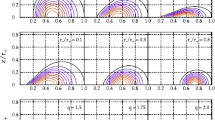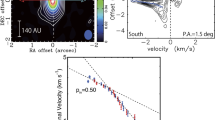Abstract
We present results of an investigation of the effects massive circumstellar disks have on the stability properties of polytropic stars. We consider systems with moderate mass disks, \(M_{d}/M_{*} = 0.2\) and 0.25 where \(M_{d}\) and \(M_{*}\) are the masses of the disk and star respectively, and with central stars in slow uniform rotation and central stars in rapid differential rotation. We study systems where the central stars are above the barlike mode secular and dynamic instability thresholds for rotating solitary stars and systems where the stars are below the barlike mode secular instability threshold for rotating solitary stars. Equilibrium systems composed of stars with massive circumstellar disks are calculated, and their stability properties determined using linear and nonlinear techniques. For the uniform rotation case, the central stars are in slow rotation in the sense that they are below barlike instability thresholds for rotating single stars. For the differential rotation case, the central stars span the range from slow rotation to rapid rotation where rapid rotation means the stars are unstable to dynamic barlike instabilities. Gravitational coupling between the star and disk drives one-armed instabilities in the slowly rotating central star case. The couple primarily forces orbital motion rather than spin-up of the star. For systems with differentially rotating central stars with slow rotation, star-disk coupling drives instability in one-armed and two-armed modes. At the fastest rotation considered, the central star becomes unstable to the barlike instability evolving in a manner similar to that found for single rapidly rotating stars. The central stars did not fission. Star-disk coupling does not strongly influence the development of the barlike mode for this case.





















Similar content being viewed by others
Notes
The Anti-spiral Theorem of Lynden-Bell and Ostriker (1967) states that dynamically stable modes in polytropic stars must have constant phase, that is, they must be purely real or purely imaginary.
References
Adams, F.C., Ruden, S.P., Shu, F.H.: Astrophys. J. 347, 959 (1989)
Armitage, P.J.: Annu. Rev. Astron. Astrophys. 49, 195 (2011)
Barge, P., Sommeria, J.: Astron. Astrophys. 295, L1 (1995)
Baruteau, C., Zhu, Z.: Mon. Not. R. Astron. Soc. 458, 3927 (2016)
Bodenheimer, P., Ostriker, J.P.: Astrophys. J. 180, 159 (1973)
Boley, A.: Ph.D. dissertation, Indiana University (2007)
Boley, A., Hartquist, T.W., Durisen, R.H., Michael, S.: Astrophys. J. 656, L89 (2007)
Casassus, S., Wright, C.M., Marino, S., Maddison, S.T., Wootten, A., Roman, P., Perez, S., Pinilla, P., Wyatt, M., Moral, V., Menard, F., Christiaens, V., Cieza, L., van der Plas, G.: Astrophys. J. 812, 126 (2015)
Friedman, J.L., Schutz, B.F.: Astrophys. J. 221, 937 (1978a)
Friedman, J.L., Schutz, B.F.: Astrophys. J. 222, 291 (1978b)
Hachisu, I.: Astrophys. J. Suppl. Ser. 61, 479 (1986)
Hadley, K.Z., Imamura, J.N.: Astrophys. Space Sci. 334, 1 (2011)
Hadley, K.Z., Fernandez, P., Imamura, J.N., Keever, E., Tumblin, R.: Astrophys. Space Sci. 353, 191 (2014)
Hadley, K.Z., Dumas, W., Imamura, J.N., Keever, E., Tumblin, R.: Astrophys. Space Sci. 359, 10 (2015)
Hawley, J.F., Smarr, L.L., Wilson, J.R.: Astrophys. J. Suppl. Ser. 55, 211 (1984)
Imamura, J.N., Friedman, J.L., Durisen, R.H.: Astrophys. J. 294, 474 (1985)
Imamura, J.N., Toman, J., Durisen, R.H., Pickett, B.K., Yang, S.: Astrophys. J. 444, 363 (1995)
Imamura, J.N., Durisen, R.H., Pickett, B.K.: Astrophys. J. 528, 946 (2000)
Kratter, K.M., Lodato, G.: Annu. Rev. Astron. Astrophys. 54, 271 (2016)
Krumholz, M.R., Crutcher, R.M., Hull, C.L.H.: Astrophys. J. Lett. 767, L11 (2013)
Lai, D.: AIPC 575, 246 (2001)
Lin, M.K., Krumholz, M.R., Kratter, K.M.: Mon. Not. R. Astron. Soc. 416, 580 (2011)
Lynden-Bell, D., Ostriker, J.P.: Mon. Not. R. Astron. Soc. 136, 293 (1967)
Papaloizou, J.C.B., Pringle, J.E.: Mon. Not. R. Astron. Soc. 208, 721 (1984)
Papaloizou, J.C.B., Pringle, J.E.: Mon. Not. R. Astron. Soc. 213, 799 (1985)
Papaloizou, J.C.B., Pringle, J.E.: Mon. Not. R. Astron. Soc. 225, 267 (1987)
Pickett, B.K., Durisen, R.H., Davis, G.A.: Astrophys. J. 458, 714 (1996)
Shariff, K.: Annu. Rev. Fluid Mech. 41, 283 (2009)
Shu, F.H., Adams, F.C., Lizano, S.: Annu. Rev. Astron. Astrophys. 25, 23 (1987)
Smith, D., Hadley, K.Z., Imamura, J.N., Dumas, W., Tumblin, R., Meades, M., Dederick, E.: Bull. Am. Astron. Soc. 223, 350.08 (2014)
Stahler, S.W., Korycansky, D.G., Brothers, M.J., Touma, J.: Astrophys. J. 341, 341 (1984)
Tassoul, J.L.: Theory of Rotating Stars. Princeton University Press, Princeton (1978)
Terebey, S., Shu, F.H., Cassen, P.: Astrophys. J. 286, 529 (1984)
Tumblin, R., Dumas, W., Imamura, J.N., Keever, E., Ranney, C.: Astrophys. Space Sci. (2019, in preparation)
van der Marel, N., van Dishoeck, E.F., Bruderer, S., van Kempen, T.A.: Astron. Astrophys. 563, A113 (2014)
Varga, A., Hadley, K.Z., Imamura, J.: Observed beating in modes of hydrodynamic simulations of protoplanetary star-disk systems Bull. Am. Astron. Soc. 231 (2018) (National Harbor MD: AAS)
Weidenschilling, S.J.: Mon. Not. R. Astron. Soc. 180, 57 (1977)
Williams, J.P., Cieza, L.A.: Annu. Rev. Astron. Astrophys. 49, 67 (2011)
Williams, H.A., Tohline, J.E.: Astrophys. J. 315, 594 (1987)
Yuan, C., Cassen, P.: Icarus 64 # 3, 435 (1985)
Zhu, Z., Baruteau, C.: Mon. Not. R. Astron. Soc. 458, 3918 (2016)
Acknowledgements
This material is based upon work supported by the National Science Foundation Graduate Research Fellowship under Grant No. 1842486. This work benefited from access to the University of Oregon high performance computers, Aciss and Talapas and from support and hospitality from Kobe University where a portion of the work was performed. The authors thank individuals who performed related work: Daniel Smith, Ethan Dederick, Willis Rogers and Alex Kuepper.
Author information
Authors and Affiliations
Corresponding author
Additional information
Publisher’s Note
Springer Nature remains neutral with regard to jurisdictional claims in published maps and institutional affiliations.
Electronic Supplementary Material
Below are the links to the electronic supplementary material.
Rights and permissions
About this article
Cite this article
Hadley, K.Z., Dumas, W., Imamura, J.N. et al. Nonaxisymmetric instabilities and star-disk coupling I. Moderate mass disks. Astrophys Space Sci 364, 119 (2019). https://doi.org/10.1007/s10509-019-3601-5
Received:
Accepted:
Published:
DOI: https://doi.org/10.1007/s10509-019-3601-5




